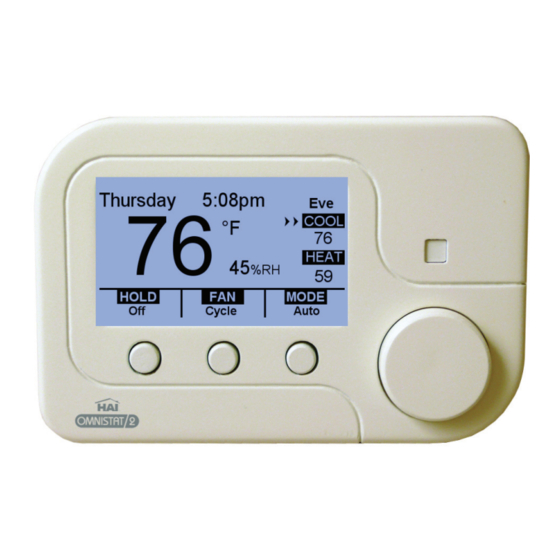
Advertisement
Table of Contents
- 1 Table of Contents
- 2 About Your Thermostat
- 3 Getting to Know Your Thermostat's Controls
- 4 Getting to Know Your Thermostat's Display (Advanced Display)
- 5 Getting to Know Your Thermostat's Display (Simplified Display)
- 6 Changing the Desired Temperature Settings
- 7 Changing the Thermostat Mode
- 8 About the Fan and Hold Settings
- 9 About the Hold Settings
- 10 Setting the Time and Date
- 11 Modifying the Program Schedule
- 12 Changing the Desired Humidity Setting (RC-2000)
- 13 Display the Runtime Graph of Air Conditioning and Heating Usage
- Download this manual
See also:
Instruction and Installation Manual
Advertisement
Table of Contents

Summarization of Contents
About Your Thermostat
Thermostat Features
Lists key capabilities like precise temperature control, programmability, remote control, and energy savings.
Understanding Thermostat Controls
Display and Input Elements
Details the large graphical display, proximity sensor, task buttons, and scroll wheel for operation.
Display Customization
Instructions for adjusting display contrast and backlight color using buttons and the scroll wheel.
Navigating Thermostat Displays
Advanced Display Layout
Overview of graphics and elements shown on the Advanced Display Home Page.
Filter Reminder System
How the thermostat tracks usage and reminds users to replace the air filter.
Advanced Display Elements Explained
Core Temperature and Mode Indicators
Explains display elements for current temperature, cool/heat settings, and thermostat mode.
Status and Operational Indicators
Details status indicators for system running, hold status, fan setting, and period indicators.
Message Bar and Humidity
Describes the message bar for notifications and relative humidity display (RC-2000).
Simplified Display Elements
Basic Display Information
Explains key elements on the simplified display: temperature, mode, and time.
Simplified Status Indicators
Details the status indicators and their meaning in the simplified view.
Setting Temperature Preferences
Adjusting Current Mode Temperature
Guide to changing the desired temperature for the currently active mode.
Setting Opposite Mode Temperature
How to adjust the temperature for the mode not currently in use.
Managing Thermostat Modes
Selecting Operating Mode
Steps to switch between Off, Heat, Cool, Auto, and Emergency Heat modes.
Mode Descriptions
Explains the behavior of Off, Heat, Cool, Auto, and Emergency Heat modes.
Fan and Hold Settings
Configuring Fan Operation
Instructions for changing the fan setting to Auto, On, or Cycle modes.
Managing Hold Status
How to set the thermostat to hold current settings (Off, On, Vacation).
Understanding Hold Options
Hold Mode Functionality
Explains how Hold Off, Hold On, and Hold Vacation modes affect schedule adherence.
Setting Vacation Hold Parameters
Guide to setting specific temperatures and duration for vacation mode.
Time and Date Configuration
Setting Time Components
Steps to set the current hour, minutes, and AM/PM indicator.
Setting Date Components
Instructions to set the current month, day, and year.
Programming Thermostat Schedule
Accessing Program Menu
How to navigate to the program schedule modification section from the Main Menu.
Selecting Day for Schedule
Choosing a specific day of the week to view or edit its programmed schedule.
Modifying Program Schedule Details
Understanding Schedule Periods
Explanation of the four daily time periods (Morning, Day, Evening, Night) and their purpose.
Adjusting Schedule Times and Temperatures
Guide to modifying start times and desired heat/cool temperatures for each period.
Advanced Schedule Management
Making and Saving Schedule Changes
Process for adjusting settings and saving modifications for a selected period.
Copying Schedule Across Days
How to efficiently copy a day's schedule to other days of the week.
Copying Schedule to Other Days
Selecting Days for Copying
Steps to choose which days to apply a copied schedule to.
Saving Copied Schedule
Finalizing the copy process to apply the schedule to selected days.
Humidity Control Settings (RC-2000)
Accessing Humidity Settings Menu
Navigating to the humidity target settings from the Main Menu.
Setting Humidity and Dehumidify Targets
Adjusting desired setpoints for humidification and dehumidification.
Viewing System Runtime Usage
Accessing Runtime Graph Feature
How to display the graph showing HVAC system runtime over the past four weeks.
Interpreting Runtime Data
Explanation of the bar graph values and what they represent for system usage.














Need help?
Do you have a question about the Omnistat2 RC-2000 and is the answer not in the manual?
Questions and answers